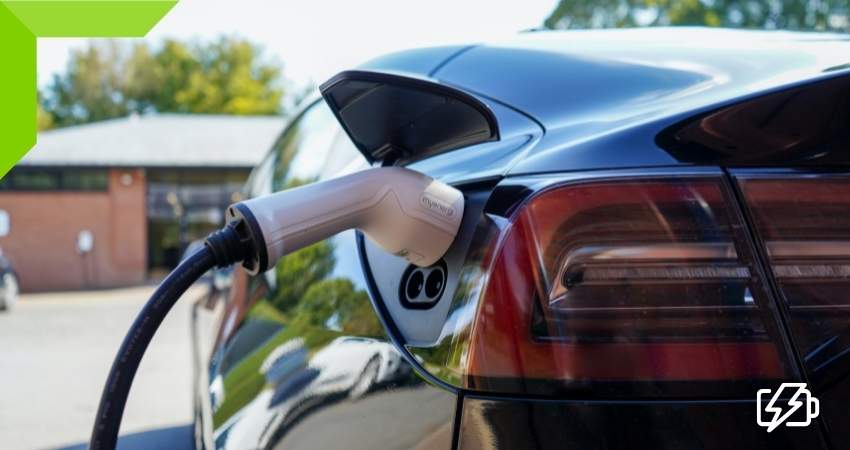If you like moving with the latest technology, you may face significant problems while charging them. Unlike combustion engine vehicles, you can avail a limited number of electric charging stations. Consequently, the charging service can be time-consuming while on a road trip.
How do you charge an electric car at home? Install a level 2 home charging station because it is the fastest electric car charger. Fit the charger into the garage or parking lot. Never do the fitting yourself; take the service of a certified electrician.
According to the National Laboratory of the US Department, Almost 80% of Routine drivers prefer using home charging stations for their electric cars as it is faster than charging stations in the city. This article will examine the process of doing it in detail.
How Can I Charge My Electric Car at Home?
You need to install a home electric charger at your car parking point. Connect the car with an EVSE supply cable with a three-pin socket. This way, your EV will start charging.
Equipment Required for Installing Charging Port
Following are the pieces of equipment you need to arrange for installing an electric car charging port.
EVSE Supply Cable
You require an EVSE “smart” cable for charging your electric car. This cable supplies 240v of voltage. It also contains the necessary electronic circuitry that allows the charging from the circuit.
3 Pin Plug Socket
An EVSE requires a standard 3-pin plug for charging cars at home. It would help if you fixed EVSE with 3-pin for better fixing the charger.
Voltage Required for Charging Electric Cars
There are two levels (level 1 and level 2) for transferring voltage to an electric car charging. We will discuss both levels in detail below.
Level 1 Charger
The first level, Level 1, is superficial; it requires only 120 volts in portable charges. You can easily plug in these chargers at home or in your garage. They don’t need any hard and fast installations. This charger is for users that have less use daily. With this charger, an hour’s worth of charging will allow your vehicle to travel 4 miles. A night’s worth of charging will allow you to travel around 30 miles.
Level 2 Charger
Electric car users prefer level 2 units. This unit needs 240 – 280 volts. You can cover a distance of 18 to 28 miles within one hour of charging from a Level 2 charger.
Tesla is a well-known brand in electric cars. These cars need 120 – 240 volt at Level 1 and Level 2 chargers. If you’re traveling more than 30-40 miles daily or using your EV as your primary car, then a 240-volt outlet will be ideal. Generally, the Level 2 charger is most popular among electric car users as it is fast and readily available at home.
How Long Does It Take to Charge an Electric Car at Home?
Charging your electric car may take a few hours. However, some other factors affect the charging speed.
- Battery size
- Battery status (full or empty)
- The maximum charging rate of your vehicle.
- The maximum charging rate of your charger.
- Weather status.

Battery Size
Most charging cars use “Lithium-ion batteries.” These batteries are available in different power variants, which are 40kWh, and 100kWh. With a large battery, you can cover a long distance. Consequently, high-power batteries need a longer time to charge.
40kWh Charge Time
The 40kWh is a small battery, so it takes around 6 hours to charge fully.
100kWh Charge Time
As a 100kWh battery is enormous and requires more energy and time, it takes around 10 hours to charge fully.
Note: This is the average time the electric car batteries take to charge. Large batteries take longer to charge.
Battery Status (Full or Empty)
As per your battery type and vehicle, it is evident that if your battery has a shallow charging point, it will take a long while. If your battery charging is 25% or 75%, you should place it for charging.
The Maximum Charging Rate of Vehicle
The charging rate depends on the brand of car you are using. For example, a Tesla takes 10 hours to charge fully. When the vehicle reaches 80% of charging, it has a system that slows down the charging rate to avoid battery damage.
The Maximum Charging Rate of a Charger
Level 1 and Level 2 both take different times to charge as they occupy different voltage levels. It also depends on which brands, Level 1 or 2, you are using.
Level 1 Charging Times
Level 1 charger with a voltage of 140V takes 8 to 10 hours for complete charging.
Level 2 Charging Times
Level 2 charger with 240V to 280V takes around 6 to 12 hours for complete charging. Remember, Level 2 gives you better mileage than Level 1; therefore, it takes more time.
Weather Status
In cool weather, the charger takes a long time to fully charge your electric car battery.
How Often Should You Charge an Electric Car at Home?
Your need for car charging depends on the usage. If you drive more than 50 miles, you are traveling more than an average American. Therefore you should be concerned about how often you need to charge an EV.
Interestingly, the cheapest and smallest Nissan Leaf will cover 149 miles after one charge. On the other hand, the basic tesla 3 model will last for 272 miles. Once you have estimated the mileage of different brands of cars, you can select the vehicle that suits your existing habits. Now, whatever vehicle model you use, you should ideally charge it between 20% and 80%. So the bottom line is that you must select a vehicle and charger according to your driving habits, whether you usually charge during the day or at night.
How Much Does it Cost to Charge an Electric Car?
In 2021 as per US Energy Information Administration, the electric charges were 13.73 cents/KWH. At this rate, if you drive 1000 miles/month, its charging cost will be $34 to $ 46. Likewise, if you charge your car to cover 300 miles at 75 to 100 kWh, you must pay $10 to $14. Remember that the charging cost depends on the cost of your state’s electricity price.
For example, if you have R1T and live in Massachusetts, where electricity costs 25.28 cents/ kWh, your charging cost will also increase by $126 at 1000 miles. While for Tesla Model 3, charging prices are 10 cents/kWh at the same distance.
Tip for the Owners: Charge the cars during the daytime if you want to lower costs. As at night time, electricity rates are at their peak.
How to Install Electric Car Charging Point at Home?
All you need now is to install a charger as per your need. We recommend you install a Level 2 charger with a voltage of 240. Select a place where you can fix the charger, ideally in your garage or the place where you park your vehicle. Now, ask your electrician to do this job by mounting the charger to the wall. The EVSE will be connected to a 3-pin socket, ensuring it is enough to reach your car charging pod.
Three Things to Consider Before Installing Any Charger At Home
You need to consider the following points while installing a charger for an eclectic car.
Safety
Safety is a pivotal point to consider while installing. For this reason, you should gather complete knowledge of your home electrical system. Also, ensure the safety of your EV charger. If you don’t have authentic knowledge of both, you may face a short circuit in wirings. It is advisable to seek help from a trained professional.
Compliance
It’s all about the certification of the battery you will use in your car or for charging. Choosing an expert EV installer is beneficial as they comply with state regulations. Therefore, they will provide you with the installation certificate after the installation. A compliance certificate in some countries is compulsory, or you must pay a fine. An expert EV charger installer can help determine compliance certification needs.
Sometimes, your charger runs out because of thunder, lightning, or other reasons. In this case, this certificate assures your insurance, and you may claim back your damages. Without this certificate, no money back or free service policy is available.
Whether the Installer is an Expert
If you don’t want to concern yourself with some government site to install your EV charger, then ensure a well-known company is installing it for you. Sometimes the highly recommended companies also don’t know the installation of these new technology chargers. Therefore, precaution should be your priority, and you should research reviews online before availing of services.
How to Optimize Charging?
Consider the following factors to optimize electric car charging at home.
Slow Driving
If you want to increase the life of your EV battery, then ensure to drive at moderate speed. This way, your car battery will run out slowly.
Charge to 80%
As we mentioned above, most cars use lithium-ion batteries in their EV. So, it’s better to charge your battery until it’s 80%. More than this scale may damage the battery life. If your battery has enough space, it can convert kinetic energy into reusable energy.
Cool Space Parking
Find shady parking when it’s a hot day, and you want to spare your charging because the battery in your car hates the heat.
Say No to Rapid Chargers
Sometimes charging your battery with a quick charger will be beneficial. However, if you make it routine and do it frequently, it will destroy the health of your car’s battery.
Deep Charging
Never be complacent about charging your car. Charge your vehicle frequently to maximize battery life, especially when the charge is below 30%.
Shut Off While Charging
Completely shut off the car while charging for maximum efficiency and battery health.
Over Charging
Most people charge their vehicle at sleep, thinking their EV will fully charge the following day. However, even with overnight charging, it is still not fully charged. Due to this habit, your car gets overcharged, and that’s not good.
How to Manage the Load on the Home Energy Supply?
Charging an electric car means adding extra load to your home electrical system as it takes more electricity than a regular home toaster, so one needs to be careful. Charging one car may not require a load management system. However, if you use more than one EV and sometimes charge them together, you need a load management system to control all the circumstances.
For example, if you charge four cars and each works at 80 amps to 40 amps, it will become challenging to manage. It is because each vehicle needs more than the amps available at home. When you place the chargers, ensure the settings through which chargers can communicate with each other. It is beneficial when a car fulfills its requirements, and the other one takes its place and distributes the current equally. Similarly, it will keep charging until one car remains.
Conclusion
How to Charge Electric Cars at Home? The answer is straightforward. All you need to do is install an EV charger with some expert electrician, whether in your backyard, garage, or where you park your car. Moreover, it would be best to remember your need to charge the car battery. As all the batteries have different voltages at which they work. However, there are mainly two car chargers – Level 1 (140 volts) and Level 2 (240 volts to 280 volts). Every battery charger takes an additional time to charge. Level 1 takes less time as it’s small and Level 2 takes a higher time in setting.


